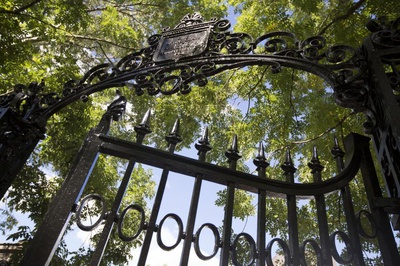
News
Harvard Grad Union Agrees To Bargain Without Ground Rules

News
Harvard Chabad Petitions to Change City Zoning Laws

News
Kestenbaum Files Opposition to Harvard’s Request for Documents

News
Harvard Agrees to a 1-Year $6 Million PILOT Agreement With the City of Cambridge

News
HUA Election Will Feature No Referenda or Survey Questions
Prevalence of Sexual Misconduct Drops Sharply at Harvard, Survey Finds

The prevalence of sexual misconduct at Harvard dropped sharply since 2019, according to results released on Monday from the Higher Education Sexual Misconduct and Awareness survey.
While the prevalence of sexual misconduct at Harvard declined significantly, graduate and undergraduate students at Harvard reported being less knowledgeable about resources on campus despite the University’s efforts to expand Title IX support for students over the past five years.
The percentage of female undergraduates who experienced sexual contact involving “physical force, inability to consent or stop what was happening, coercion, or without voluntary agreement” dropped from 32.5 to 22.1 percent, while for the gender nonbinary, transgender, questioning, or self-identified group, the same figure decreased from 24.8 to 14.7 percent.
However, students also expressed less confidence in the University’s ability to investigate cases of sexual misconduct this year, in addition to being less knowledgeable about campus resources.
Across all gender identity groups, at all colleges surveyed, the percentage of individuals who responded that they believe a campus official would take a report of sexual assault or other sexual misconduct “very” or “extremely” seriously dropped significantly from 2019.
The aggregate data showed a decline from 54.6 in 2019 to 45.4 percent in 2024 for undergraduate women and 75.8 to 67.6 percent for undergraduate men.
At Harvard, the number for undergraduate women fell even more sharply from 49.3 percent to 37.7 percent. For undergraduate men the decline was even more significant, dropping by nearly 20 percentage points from 74.7 percent in 2019 to 55 percent in 2024.
Harvard President Alan M. Garber ’76 wrote in a University-wide email on Monday announcing the results that despite a “statistically significant decline in sexual misconduct since the most recent AAU Survey in 2019, its prevalence remains alarmingly high and challenges the notion that all members of our community are able to pursue their academic and professional work unhindered.”
“One instance of sexual assault or sexual harassment is too many,” Garber added.
The HESMA survey was administered during the month of April to students at 10 universities in the United States, and was focused on assessing campus climate on matters pertaining to sexual assault and sexual misconduct. This year marked the third time Harvard was included in the survey, after previously participating in 2015 and 2019.
The survey consisted of a core set of 54 questions, with additional follow-ups if a respondent reported being “victimized.” Each potential respondent was offered a $20 gift card to complete the survey, but of the 24,115 enrolled students invited to participate, just 35.1 percent completed the survey — a 1 percent decline from 2019 and an 18 percent decline from 2015.
Garber wrote in his statement that he was “encouraged” by the participation level, which was more than 10 percentage points higher than the average participation rate for the other institutions taking part in the survey.
Aside from the inclusion of more categories for gender identity markers, disability status, and sexual orientation, the 2024 questionnaire “replicated the 2019 AAU survey” to allow schools to track changes since 2019, according to the HESMA report.
Following the 2019 survey, the Title IX office under the Office for Gender Equity underwent significant changes and reprogramming. The Title IX Office and the Office for Sexual Assault Prevention and Response office were dissolved in 2021 and moved under the OGE as one entity — causing concern that students would be less willing to seek out confidential help if they thought those services would be entangled with Title IX reporting processes.
New positions have also been added to the team. In August, Lindsey Ciolfi was appointed assistant director of College Title IX, a newly created role.
In addition to staffing expansions, there have been considerable policy changes in the past five years. In 2022, Harvard proposed changes to its discrimination and sexual harassment policies to update the University-wide definition of consent to require “active, mutual agreement.”
The survey asked undergraduate women whether they had experienced sexual harassment “since entering” school. The reported rate of harassment was 8.1, 17.2, 21.9, and 21.3 percent for first-year, second-year, third-year, and fourth-year or higher students, respectively.
Most members of the Class of 2024, who were in their fourth year at the time the survey was collected, started college at the height of the Covid-19 pandemic in fall 2020, which was marked by restrictions on social activities, online classes, and fewer students present on campus.
Still, despite changes to Title IX programming at Harvard in the past five years, the rate of undergraduate women who reported being knowledgeable about resources for help if they or a friend experienced sexual assault or misconduct saw a statistically significant decline from 47.6 percent in 2019 to 38 percent in 2024.
Similarly, the percentage of undergraduate women who stated they were knowledgeable about where to make a report on an incident of sexual assault or sexual misconduct declined sharply from 32.3 percent to 29.4 percent in the last five years. The same figure for undergraduate men declined from 40.4 to 35.0 percent.
Despite this, female undergraduates at Harvard who experienced nonconsensual sexual contact involving physical force or inability to consent as a result of penetration contacted a program or resource at a higher percentage than the average across all surveyed schools. At Harvard, just over 56 percent said they did not contact a program or resource, while the same figure was 69.8 percent in the aggregate report.
The most common reason for not using available resources — cited by 58.3 percent of female respondents — was “I could handle it myself.” The second-most commonly cited reason, listed by 34.7 percent of female respondents, was that they did not believe the matter was “serious enough” to seek support from available resources.
Peggy Newell, vice president and deputy to the president, said in an interview with the Harvard Gazette, a University-run publication, that “a critical part of this communication involves engagement with our faculty and staff.”
In the coming weeks, an updated version of the required eLearning course addressing sexual harassment and other sexual misconduct will be assigned to all faculty, staff, and postdoctoral fellows in order “to encourage this dialogue,” according to Newell.
“This is an important conversation for every member of our community,” she said.
Corrections: October 21, 2024
A previous version of this article incorrectly referred to the OGE as the Office of Gender Equity. In fact, it is the Office for Gender Equity.
A previous version of this article incorrectly stated that the Title IX Office and the Office for Sexual Assault Prevention and Response office were merged in 2021. In fact, the offices were dissolved and moved under the OGE as one entity.
Correction: October 23, 2024
A previous version of this article incorrectly stated that the University updated its sexual harassment policies to require “active, mutual agreement.” In fact, the University has only proposed the update.
—Staff writer Caroline K. Hsu can be reached at caroline.hsu@thecrimson.com. Follow her on X @CarolineHsu_.
—Staff writer Hana Rostami can be reached at hana.rostami@thecrimson.com.
Want to keep up with breaking news? Subscribe to our email newsletter.
Most Read
- Harvard Dismisses Leaders of Center for Middle Eastern Studies
- More Than 80 HLS Professors Denounce Trump Admin Attacks on Law Firms in Letter to Students
- 2 Years After Affirmative Action Ruling, Harvard Admits Class of 2029 Without Releasing Data
- Harvard Agrees to a 1-Year $6 Million PILOT Agreement With the City of Cambridge
- FAS Dean Asks Center Directors To Show Compliance With Viewpoint Diversity Guidance
From Our Advertisers

Over 300+ courses at prestigious colleges and universities in the US and UK are at your disposal.

With innovative financial tools combined with financial education, Collegiate empowers students to take control of their finances and build confidence in their money management skills.

Serve as a proctor for Harvard Summer School (HSS) students, either in the Secondary School Program (SSP), General Program (GP), or Pre-College Program.

With an increasingly competitive Law School admissions process, it's important to understand what makes an applicant stand out.

Welcome to your one-stop gifting destination for men and women—it's like your neighborhood holiday shop, but way cooler.

Admit Expert is a premium MBA admissions consulting company, helping candidates secure admission to top B-schools across the globe with significant scholarships.
